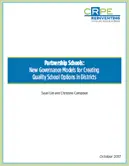In at least 10 U.S. cities, a new partnership schools model is emerging. This “third way” governance strategy can break through contentious district-charter divides and could help improve struggling schools or increase the number of high-quality neighborhood options.
How are partnership schools unique?
Like charter schools, partnership schools enjoy more freedom of action than traditional district schools. Yet they are legally distinct from charter schools; rather than seeking authorization, they enter into contracts with districts to become special district schools.
Benefits and risks for families, principals, teachers, districts, and charters
As this brief shows, while there are risks to implementation, partnership schools may be the next stage in district-charter collaboration or become part of a city’s portfolio management strategy, offering new options for families; empowering principals, teachers, and families in new ways; and providing a financial benefit to districts worried about declining enrollment.
Motivations and challenges for districts and charter operators
While the partnership schools approach is promising, the theory of change is largely untested and student outcomes not yet studied. Read CRPE’s brief to learn more about these models, the motivations and challenges for districts and charter operators, and the questions that they and policymakers, researchers, and others need to consider before implementing and supporting partnership schools.





